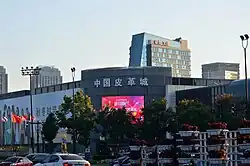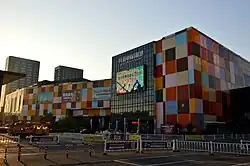Leather industry in China
The leather industry in China is a significant sector within the country's manufacturing and export economy, recognized as the world's largest producer of leather by volume. It encompasses the production of leather goods, including garments, footwear, and accessories, with major industrial clusters in regions such as Guangdong, Zhejiang, and Hebei provinces. The industry grew substantially since the 1980s, driven by economic reforms, low labor costs, and abundant raw materials.[1][2]
History
The leather industry in China has historical roots dating back over 3,000 years to the Shang Dynasty, when tanning was practiced in areas like Xinji, Hebei Province.[3][1] However, modern industrial growth began in the early 1980s following China's economic reforms and opening-up policies. Small workshops, often established by former state-owned tannery workers, emerged to process sheepskins and other hides, primarily for local markets.


The 1990s marked a period of rapid growth, fueled by foreign investment, advanced tanning technologies, and export-oriented policies. Industrial clusters, such as Xinji City in Hebei and Haining Leather City in Zhejiang, became key production hubs.[4] By 2001, Xinji alone produced 15% of the world’s sheepskin garment leather, with an output value of US$600 million, of which US$250 million was from exports.[5]

By the 2000s, China solidified its position as the global leader in leather production and exports.[6] In 2009, the leather industry’s export value reached over US$56 billion, driven by footwear (67% of global shoe production) and leather goods (36% of global exports). The industry saw further consolidation, with tanning clusters in Hebei undergoing restructuring to improve efficiency and environmental performance. By 2012, China’s leather exports reached US$75 billion, surpassing competitors like Italy and Vietnam.[7]
Production and export
Major production centers
China’s leather industry is concentrated in several regions:
- Xinji, Hebei Province
- Shiling, Guangzhou, Guangdong Province
- Haining, Zhejiang Province
- Other notable regions include Wenzhou (leather shoes), Jinjiang (sneakers), and Chengdu (leather shoes).
Export markets
China exports leather goods to over 130 countries, with key markets including Russia, the United States, Germany, Japan, and Eastern Europe.[8] In 2000, China’s leather and footwear exports totaled US$17.47 billion, the highest globally.[9] Russia is a major destination for sheepskin garment leather.[10] Exports are facilitated through direct channels and intermediaries in Hong Kong and South Korea, with products ranging from fur coats to footwear and accessories.
In 2021, China held the position of the world's leading exporter of leather goods, accounting for 29% of global exports.[11]
Environmental impact
The leather industry has faced criticism for its environmental footprint, particularly due to wastewater from tanning processes.[3] In 2009, the industry discharged over 249 million cubic meters of wastewater, making it one of China’s top 20 water polluters.[12] Tannery effluents often contain toxic heavy metals, chromium, and high levels of Chemical Oxygen Demand (COD) and Biological Oxygen Demand (BOD).
Historically, small manufacturers prioritized cost over environmental compliance, leading to widespread pollution. The industry’s reliance on chromium tanning (used in 80% of global leather production) exacerbates water and soil pollution.[13] In some places wastewater was found to contain hexavalent chromium, a carcinogen, found in soil several times above government standards.[14]
References
- ^ a b Admin, Cms (2002-09-11). "Xinji City - the garment leather capital". Leather International. Retrieved 2025-07-20.
- ^ "THE LEATHER AND LEATHER PRODUCTS INDUSTRY UP TO 1985*" (PDF).
{{cite web}}:|first=missing|last=(help) - ^ a b "Can China's 'Leather Capital' Repay Its Environmental Debts? - Caixin Global". www.caixinglobal.com. Retrieved 2025-07-20.
- ^ "Into Leather: State-led Development and the Private Sector in Xinji*" (PDF).
{{cite web}}:|first=missing|last=(help)CS1 maint: multiple names: authors list (link) - ^ Admin, Cms (2002-09-11). "Xinji City - the garment leather capital". Leather International. Retrieved 2025-07-20.
- ^ https://pure.manchester.ac.uk/ws/portalfiles/portal/204270830/Chapter_8_Leather.pdf
- ^ "Leather: Time for Business Unusual". CWR. Retrieved 2025-07-20.
- ^ "Hebei Bamailong Industry Corporation (Group)|fur fur garmet Nick's clothes cashmere dust coat ||简介". China Textile & Apparel Online: China Textiles and Clothing Directory - Hebei Bamailong Industrial Group Co., Ltd. Retrieved 2025-07-20.
- ^ Admin, Cms (2002-02-06). "Still largest volume producer of leather". Leather International. Retrieved 2025-07-20.
- ^ "The Future Trends and Expected Status of the World Leather and Leather Products Industry and Trade" (PDF). January 2010.
{{cite web}}:|first=missing|last=(help) - ^ "Leather Goods: export value share by country worldwide". Statista. Retrieved 2025-07-20.
- ^ "Sustainable Leather: More Steps to go…". CWR. Retrieved 2025-07-20.
- ^ Thomasset, Agnès; Benayoun, Stéphane (2024). "Review: Leather sustainability, an industrial ecology in process". Journal of Industrial Ecology. 28 (6): 1842–1856. Bibcode:2024JInEc..28.1842T. doi:10.1111/jiec.13547. ISSN 1530-9290.
- ^ Xie, Panpan; Liu, Zhenao; Li, Jin; Ju, Diandong; Ding, Xiaoyong; Wang, Yuze; Hower, James C. (2023-03-01). "Pollution and health-risk assessments of Cr-contaminated soils from a tannery waste lagoon, Hebei, north China: With emphasis on Cr speciation". Chemosphere. 317 137908. Bibcode:2023Chmsp.31737908X. doi:10.1016/j.chemosphere.2023.137908. ISSN 0045-6535. PMID 36681196.